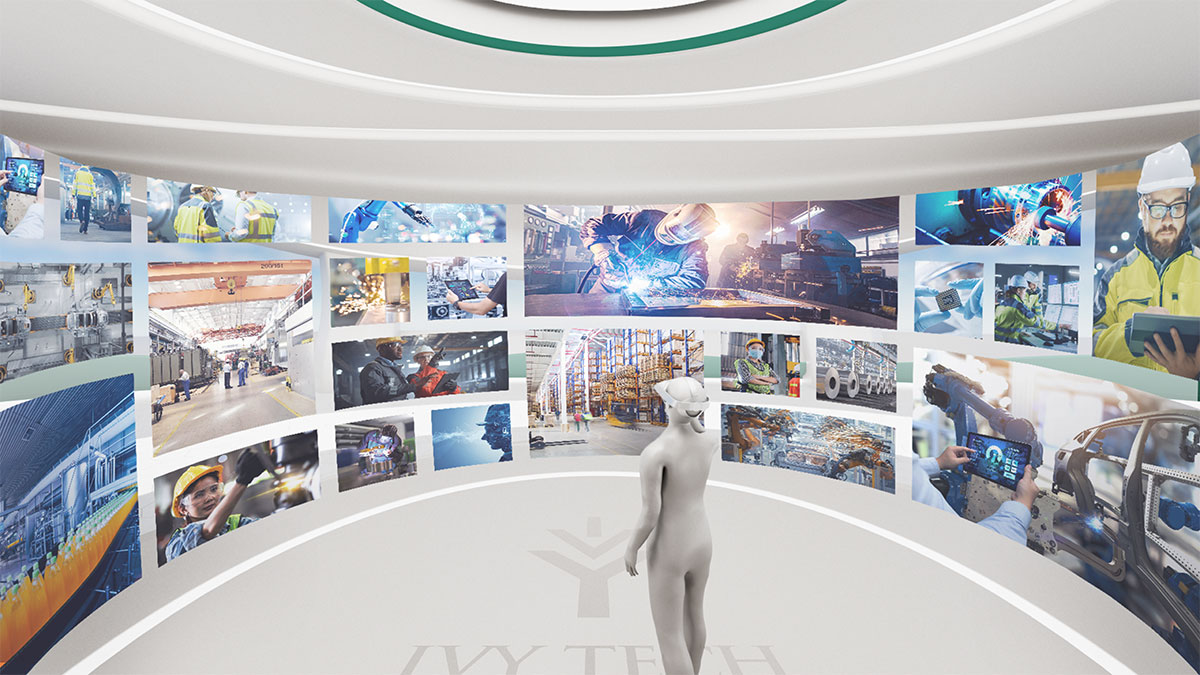Subscriber Benefit
As a subscriber you can listen to articles at work, in the car, or while you work out. Subscribe NowIndianapolis-based VisionThree Inc. is launching an ambitious effort to harness the power of virtual reality to help solve the state’s ongoing talent shortage.
Since its founding in 2003, VisionThree has made a name for itself by creating interactive touch displays and virtual-reality content for clients such as Eli Lilly and Co., Indiana University, Rolls-Royce, Raytheon Technologies and Siemens.
Now, it is venturing into new territory with a project it calls V3Connect. The $80 million effort aims to place virtual-reality career labs in every high school, community college and university in Indiana by 2025. The project has been in the works since late last year, and organizers plan to roll out a test version in September.
The concept: Companies will pay VisionThree to create custom content that showcases career opportunities at their business and gives a taste of what it’s like to work in selected jobs. Students will access the virtual-reality content via a career lab at their school, giving them a chance to explore jobs and career opportunities they might never have considered otherwise.
A big goal, for sure—but the project has already attracted support from numerous partners, including the Indiana Economic Development Corp. and Ivy Tech Community College, which see big potential in V3Connect.
Tony Denhart, executive vice president of workforce and talent at the IEDC, said V3Connect is another tool the state can use in its efforts to build a strong talent pipeline. “We’ve got to make some big, bold moves—and I consider this to be a big, bold move.”
In the test version, VisionThree will send a mobile VR career lab around the state. The lab will feature content from a fictional company, Acme Engine, so VisionThree can gather feedback on what users like and how they interact with the system. VisionThree will also work with a Vanderbilt University scholar for guidance on effective content development.
The company plans to begin adding customized content from partner companies in October.
Once students don the VR headsets, they will select areas of interest, then have an immersive experience based on those interests. A student who likes to interact with people, for instance, might learn what it’s like to work as a salesperson at Company X. Another who likes hands-on work might get to experience a day in the life of an engineer or a technician, stepping into a virtual version of a company’s manufacturing space to interact with equipment. Students might learn about opportunities with employers in different parts of the state, depending on their preference for urban or rural living.
“Every single user will have their own experience with this,” said Heather Jackson, VisionThree’s chief revenue officer.

Early interest
Jackson said VisionThree already has identified multiple companies interested in signing up, pending the results of the pilot.
“We have several that are poised and ready,” she said, adding that VisionThree’s initial goal is to sign up 15 partner companies by year’s end.
Jackson said the number of companies VisionThree can add over time will be determined by its development capabilities. The 20-person firm expects to grow its head count about 30% over the next few months, in part to handle the extra work it expects to pick up through V3Connect.
The first 15 partner companies will pay a reduced fee of about $75,000 to cover the costs of creating their custom content. The fee for subsequent companies will double to $150,000. Companies will also be asked to pay an annual fee to update and refresh their content, with fees varying depending on how much work is involved.
Project supporters say V3Connect can connect with students in a whole new way, helping to build the state’s talent pipeline—especially in key areas like manufacturing, health care, logistics and entrepreneurship.
“It’s not only an educational tool—it’s a direct connection to workforce needs,” said Caroline Dowd-Higgins, Ivy Tech’s vice president of career coaching and employer connections.
Dowd-Higgins said Ivy Tech plans to install a V3Connect career lab at one of its campuses within six months, though that location hasn’t yet been identified. After gauging the success of that site, Ivy Tech will decide whether to add labs at additional sites.
Dowd-Higgins said she’s especially excited about V3Connect’s potential to help both current and prospective students. People could come to the career lab to learn about potential career paths, then Ivy Tech could match users with the degree or certification programs needed for those careers.
“We believe this is an investment that will have a terrific return to boost recruitment and retention and job placement,” Dowd-Higgins said.
Ivy Tech is working with VisionThree to determine the costs of hosting a V3Connect career lab, she said—costs that include providing a secure space for the equipment, maintaining the lab and perhaps having a dedicated staff person to run the lab.
In a bid to make the program more appealing to schools, VisionThree is working with an outside company to set up dedicated internet connections for each lab.
Virtual-reality applications require a reliable high-speed internet connection, and having the career lab on its own system means schools will not be sacrificing their other online needs, said Dawn Lang, VisionThree’s vice president of strategic partnerships.
“If we make it as easy as possible for [schools] to use, they’ll use it,” Lang said.
The dedicated connections, she said, will be especially important for schools in rural areas where high-speed internet service is not always available. She said several universities and school districts, including districts in rural areas, have already expressed interest in hosting career labs.
If a school can’t afford to bear some of the costs of hosting a lab, Lang said, VisionThree will help it identify grant programs or philanthropic sources to help defray costs.
Funding
VisionThree describes V3Connect as an $80 million program. That includes everything from content development to hardware, equipment installation and maintenance, and the cost of the internet connections to power each site around the state.
Jackson said she expects about half of the $80 million to come from the fees partner companies pay for content development and annual updates. The other half is expected to come from grants, charitable gifts and other sources that will help both schools and smaller companies cover their participation costs.
Denhart said the IEDC will likely offer some level of financial support, though he declined to give details. “We are very early in this partnership.”
He described V3Connect as the “reimagining of recruiting,” which can help break down barriers to career exploration and talent development.
Sometimes, he said, the barrier might be a simple misunderstanding or lack of knowledge about what a particular industry or company is like. Other barriers are geographic. Virtual reality, he said, can eliminate all of them.
“It’s going to be tough for someone in southwest Indiana to take a field trip to Warsaw, the orthopedic capital of the world,” Denhart offered as an example. “This [virtual reality] will take them right there.”
An effort like V3Connect could also help attract companies to Indiana, he said, because it gives them a way to directly reach out to prospective future employees.
Especially now that skilled talent is in such short supply, Denhart said, companies considering an Indiana location are keenly focused on the state’s ability to deliver skilled workers. “Workforce is the first thing, the middle thing and the last thing they talk about.”•
Please enable JavaScript to view this content.




